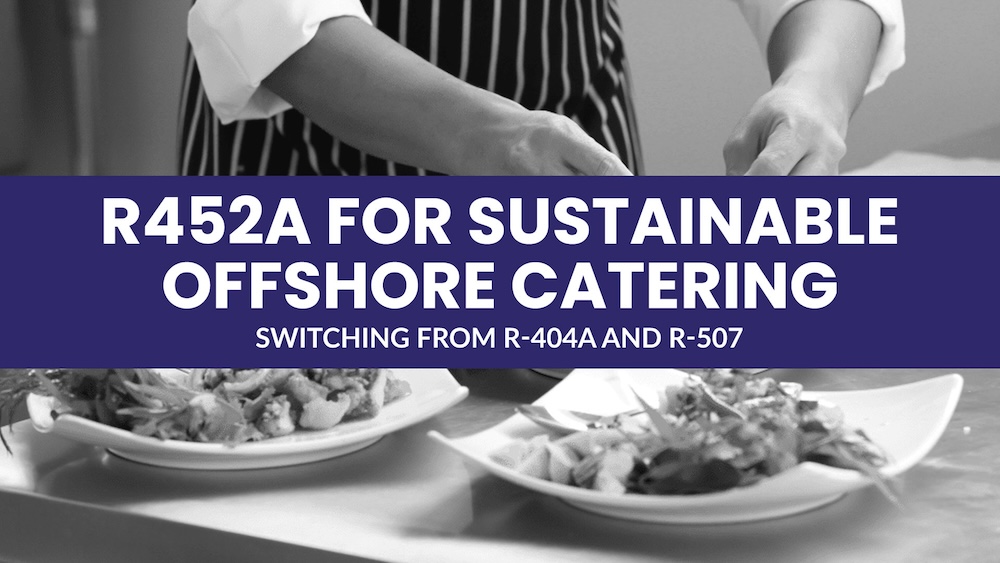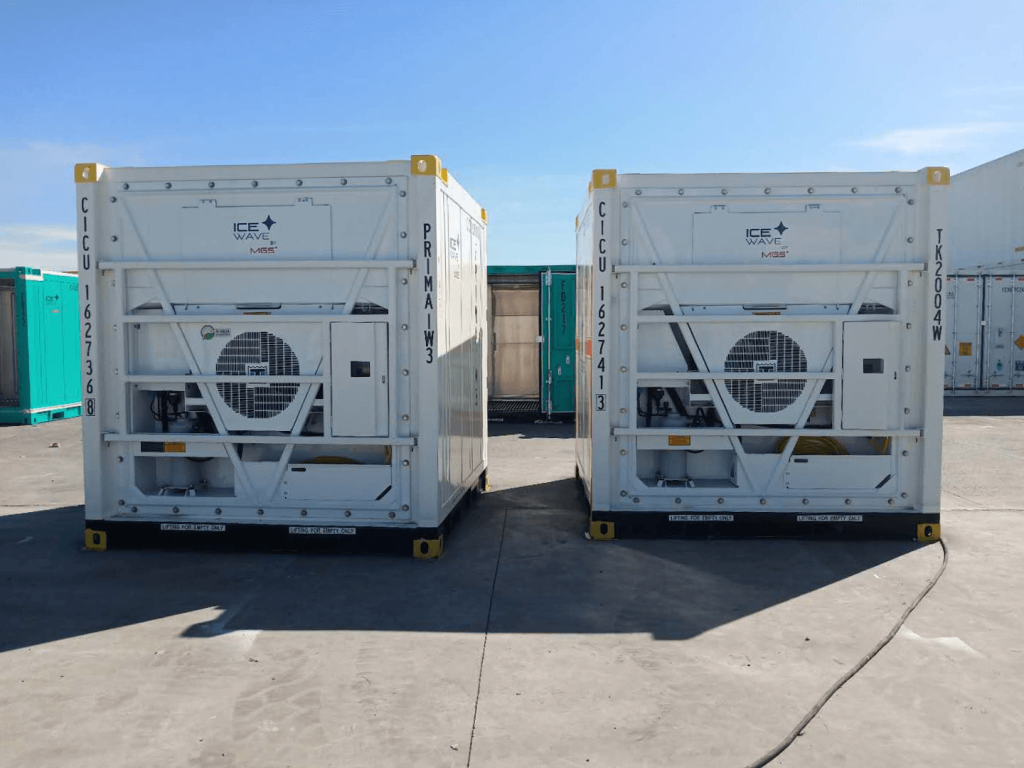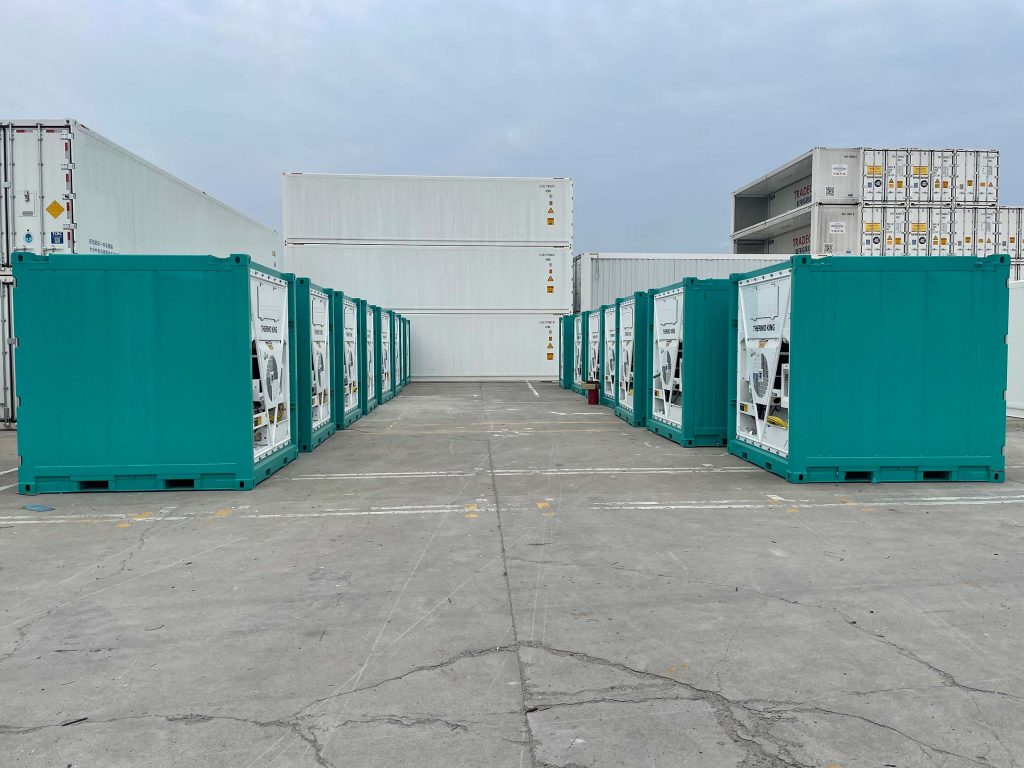As the shipping industry grapples with the environmental impact of traditional refrigerants, a paradigm shift towards eco-friendly alternatives is underway. Embracing eco-friendly alternatives not only aligns with global sustainability regulations but also underscores the shipping industry’s commitment to mitigating climate change.
This informational blog post delves into the significance of R452A, an environmentally conscious refrigerant, and its application in offshore reefer containers. Let’s explore the journey from the conventional R-404A and R-507 to the promising R452A.
The role of refrigerants in offshore catering
Before diving into the specifics of R452A, it’s crucial to understand refrigerants’ pivotal role in offshore catering. Refrigerants are the lifeblood of reefer containers, guaranteeing the preservation of perishable goods during transportation.
In practice, refrigerants collect heat in a suitable fluid. This heat is then withdrawn from the space material to be cooled—effectively bringing the heat with it.
The refrigerants employed in offshore reefer containers are typically deployed in the compressor, condenser, and evaporator systems. Furthermore, they must meet specific specifications.
Some of the prevalent primary refrigerants deployed in offshore reefer containers include R134A, R507 and R404A. Secondary refrigerants are utilised to transfer heat from the primary refrigerant to the cargo being transported.
They are usually water-based and employed in a closed-loop system. Secondary refrigerants used in offshore reefer containers may include propylene glycol and ethylene glycol
Generally, the refrigeration technology and the type of refrigerant utilised significantly impact the energy efficiency of offshore reefer containers. This makes it essential to select the most suitable refrigerant for the intended application.
What are R-404A and R-507?
R-404A and R-507 are common refrigerants deployed in offshore shipping containers. R-404A is a high-temperature refrigerant blend. R-507 is a non-chlorine azeotropic mixed refrigerant.
Generally, R-507 is usually preferred for its environmental properties as a non-chlorine-based refrigerant. This makes it a more eco-friendly alternative.
Nonetheless, the choice between R-404A and R-507 encompasses considerations like temperature requirements, environmental impact, and regulatory compliance.
Environmental impact of traditional refrigerants
Traditional refrigerants like R-404A have been the go-to choices for many years in offshore reefer containers. However, their negative environmental impact cannot be ignored.
This refrigerant’s constituents are known to contribute to ozone layer depletion. For context, R404A contain chlorine, which, when released into the atmosphere, can lead to the breakdown of the ozone layer.
This, in turn, allows more ultraviolet (UV) radiation to reach the Earth’s surface. Thus, posing risks to human health, ecosystems, and materials.
Additionally, R-404A is made up of potent greenhouse gases, with high global warming potential (GWP) values i.e., a GWP of 3,922. This means it has 3,922 times the warming effect of the equivalent amount of carbon dioxide over 100 years.
Fortunately, alternative refrigerants that are more environmentally friendly exist such as R-507. Unlike R-404A, R-507 does not contain chlorine.
Therefore, R-507 is favoured for its environmentally friendly properties. This makes it suitable for shipping containers where sustainability and regulatory adherence are key concerns.
What is R452A refrigerant?
R452A has emerged as a game-changer in the quest for sustainable offshore catering. Comprising a blend of HFC-32, HFC-125, and HFO-1234yf, R452A boasts properties that align with environmental responsibility.
Also known as Opteon XP44, this hydrofluoroolefin (HFO) refrigerant is a more environmentally sustainable alternative to traditional high-GWP refrigerants like R-404A.
It aligns with the industry’s efforts to embrace green and sustainable practices, ultimately driving positive environmental outcomes and promoting a more sustainable future for offshore catering.
Comparison of R452A with R-404A and R-507
Refrigerants are pivotal components in the realm of refrigeration and air conditioning, playing a crucial role in maintaining optimal temperatures for various applications.
R-404A and R-507 are traditional hydrofluorocarbon (HFC) refrigerants that have been widely used in the shipping and offshore catering industries.
Performance
R452A not only matches but often surpasses the performance of its predecessors. Its thermodynamic properties ensure efficient cooling— maintaining the integrity of perishable goods throughout the shipping journey.
Environmental impact
The environmental advantages of R452A are profound. With a significantly reduced global warming potential, it stands as a beacon of sustainability in contrast to the environmentally harmful R-404A and R-507.
Safety
Safety is paramount in offshore catering. R452A exhibits mild flammability under certain conditions, necessitating adherence to stringent safety protocols. However, with proper training and precautions, its safe handling can be ensured.
Operational advantages
R452A brings operational advantages, notably in energy efficiency. The switch to R452A can contribute to reduced energy consumption, aligning with the industry’s push for greener practices.
Regulatory and industry trends
As regulations governing refrigerant use evolve, the industry is witnessing a shift towards sustainable alternatives. Understanding these evolving trends is essential for making informed decisions about adopting eco-friendly refrigerants like R452A.
Implementing R452A in offshore catering operations
To transition from R-404A and R-507 to R452A, here are a few steps you may follow:
1. Assessing current refrigeration systems
- System evaluation: Thoroughly evaluate existing systems for compatibility with R452A.
- Professional consultation: Seek advice from refrigeration experts for tailored guidance.
2. Planning the transition
- Transition strategy: Develop a comprehensive plan, including timelines, budgeting, and risk management.
- Regulatory compliance: Ensure to comply with local and international regulations during the transition.
3. Retrofitting and system optimisation
- Retrofitting process: Reframe existing systems for R452A, replace components, and make necessary adjustments.
- Optimisation for efficiency: Enhance the system for maximum efficiency by adjusting expansion devices, compressors, and control systems.
4. Training and safety
- Staff training: Provide comprehensive training on R452A handling, safety protocols, system operation, and emergency procedures.
- Safety measures: Implement stringent safety processes in consideration of R452A’s properties.
5. Monitoring and maintenance
- System monitoring: Regularly monitor the system to ensure efficient and safe operation.
- Preventive maintenance: Schedule regular maintenance to prevent issues and extend the system’s lifespan.
6. Documentation and record-keeping
- Maintaining records: Keep detailed records of the transition process, system modifications, maintenance schedules, and safety training for regulatory compliance and future audits.
Challenges and solutions
While the transition from R-404A and R-507 to R452A brings promising environmental benefits, it is not without its challenges. Catering operations in the offshore industry may face obstacles during this shift.
Identifying these challenges and implementing effective solutions is crucial for a seamless and successful transition.
- Initial costs: The upfront costs associated with retrofitting systems and acquiring the new R452A refrigerant may be perceived as a financial burden.
So, develop a comprehensive budgeting strategy, considering long-term savings from improved energy efficiency. Furthermore, explore financial incentives or grants to offset initial costs.
- Technical adjustments: Retrofitting existing systems to accommodate R452A may require technical adjustments and component replacements. So, engage with experienced refrigeration experts to ensure a thorough assessment of existing systems.
Additionally, collaborate with manufacturers specialising in retrofitting for a seamless transition.
- Supply chain issues: Ensuring a steady and reliable supply of R452A refrigerant could be challenging due to market demand and supply chain intricacies. So, establish strategic partnerships with reputable suppliers to secure a consistent source of R452A. Additionally, consider building a buffer stock to mitigate potential disruptions.
- Regulatory compliance: Faithfully adhering to local and international regulations during the transition may pose challenges, leading to compliance issues.
So, stay informed about regulatory requirements, seek legal counsel for effective compliance, and establish a dedicated team. Or hire professionals with expertise in regulatory compliance.
- Training and safety concerns: Introducing a new refrigerant like R452A requires comprehensive training for catering and technical staff to ensure safe handling. So, conduct extensive training sessions covering safety protocols, and emergency procedures.
Additionally, implement stringent safety measures, considering the mildly flammable nature of R452A under certain conditions.
- Monitoring and maintenance: Ensuring the continued efficiency and safety of the refrigeration system with R452A requires regular monitoring and maintenance. So, emplement a robust monitoring system to detect anomalies promptly.
Furthermore, schedule preventive maintenance to extend the lifespan of the refrigeration system, minimising potential issues.
- Documentation and record-keeping: Keeping accurate records of the transition process, system modifications, and safety training can be challenging but is essential for regulatory compliance.
So, establish a comprehensive documentation system with detailed records of each step in the transition process. Also, conduct regular audits to ensure documentation meets regulatory standards and is readily available for inspection.
The role of environmentally friendly offshore reefer containers
These specialised containers, designed with eco-conscious principles, go beyond merely preserving perishable goods—they contribute significantly to reducing the carbon footprint associated with offshore catering.
Here’s a closer look at the key aspects of their role:
Energy efficiency: Traditional reefer containers often consume substantial energy, contributing to higher operational costs and increased environmental impact.
Environmentally friendly reefer containers prioritise energy efficiency through advanced insulation materials and state-of-the-art cooling technologies. Thereby, minimising energy consumption and operational expenses.
Reduced emissions: Conventional containers may rely on refrigerants with high global warming potential—exacerbating climate change concerns.
On the other hand, environmentall friendly ones adopt eco-friendly refrigerants, such as R452A—with lower global warming potential. Thus, aligning with sustainability goals and reducing overall emissions.
Innovative design for sustainability: Traditional containers may lack features that enhance overall sustainability and environmental performance.
In contrast, environmentally friendly containers boast innovative designs that prioritise sustainability. They also incorporate features like solar panels for auxiliary power, energy-efficient LED lighting, and recyclable materials in construction.
Temperature control precision: Inaccurate temperature control in traditional containers can lead to food spoilage and waste.
Modern, environmentally friendly reefer containers leverage remote temperature control systems— ensuring precise monitoring and management of internal conditions. This not only reduces food waste but also augments the quality and safety of transported goods.
Compliance with green initiatives: Meeting evolving environmental standards and green initiatives is a growing concern for the shipping industry.
Environmentally friendly containers align with and often surpass regulatory requirements. This consequently positions catering operations at the forefront of sustainable practices, fostering a positive corporate image.
Lifecycle considerations: The environmental impact of containers extends beyond operational use to their manufacturing and disposal.
Newer environmentally friendly reefers are designed with a holistic lifecycle approach, incorporating sustainable materials and construction methods. Additionally, end-of-life considerations prioritise recyclability and minimise environmental impact.
Read: Things you need to know about eco-friendly reefers
Conclusion
The transition from R-404A and R-507 to R452A represents a significant stride towards sustainable offshore catering. By embracing eco-friendly refrigerants and implementing meticulous transition strategies, the shipping industry can not only reduce its environmental footprint but also enhance operational efficiency.
As offshore catering operations strive to enhance environmental stewardship, MGS’s reefers that employ R452A refrigerants may emerge as a vital component in achieving this goal.

Business Director
A graduate (Business) from KDU, Jason Tan, is the current Business Director (Sales) for MGS Icestorm and has been associated with the company for the past 10 years.
With over 13 years in the shipping industry, he has had a significant contribution to Malaysia’s oil and gas industry in the engine and boat supply sector.
His expertise includes managing offshore catering business, offshore reefer containers, AI technology, offshore gas tanks, A60 pressurized cabins, etc. His contributions have helped establish MGS, in partnership (joint venture) with Thermo King and Honeywell to produce state of art Offshore Reefer Container products.



